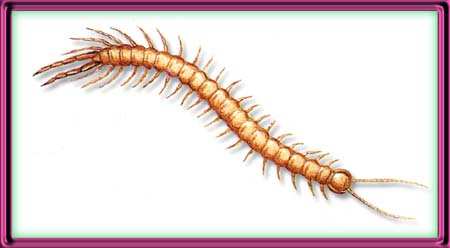
This is the laddie which is not a lithobiid...Oh! no...he's got a better name than that...how does "scolopendromorph" grab you...not bad is it.This group actually includes the largest and most dangerous centipedes, such as Scolopendra gigantea from tropical America. This is a big boy and measures in at a foot long...Yeees...12 inches, and it eats mice and toads. But, compared to these giants, our little cryptops is very insignificant. He measures about 20 to 30 mm long and little more than 1 mm broad, it is a pale brown animal with 21 pairs of legs. It has no eyes, although it is very active animal like the lithobiids. The antennae are no more than about a quarter the length of the body. A single shield or tergite covers the first trunk segment and the segment bearing the poison claws, so that both the claws and the front legs appear to spring from the same segment. The tergites of the trunk segments are all more or less the same size, although there is a very slight trace of the alternation that is seen in lithobiids. The legs are relatively short compared with those of the lithobiids and the animal is not quite so fast. The last pair of legs are much stouter than the others and they are probably used as offensive or defensive weapons. Cryptops hortensis is widely distributed, although not common, in woodlands, fields and gardens in England and Wales, but it seems to have a particular liking for gardens. The species is also found in the wild in Ireland, but Scottish records suggest that it lives there only in association with man. As in the geophilid species, the female cryptops looks after her eggs and young for a while. The babies emerge from their eggs with their full quota of legs.
Back to main Casual Intruder page